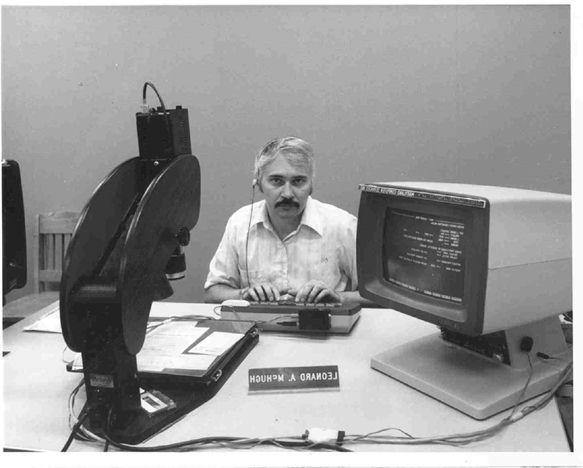
Photo: Lenny at the helm of the world's first talking computer"
February 1968, I began my career with the Pennsylvania Department of Highways later to become the Pennsylvania Department of Transportation. Here is where I first started working with the Burroughs Computers. By having the computer punched cards processed by a machine called an interpreter I was able to read them. This machine reads the card punches and types the character near the top. I would do this process two or three times making the print very dark. I would also request all printed output on carbon copied paper. The second copy was always dark. This allowed me to be able to read the program listings as well as locating cards that needed corrections.
As time went by technology improved as my sight simultaneously decreased. In the mid-1970s I acquired a full size close circuit television system that had a magnifying lens. With this I could read listings and some cards when necessary.
As upgrades to the computer were made a computer terminal called a CONRAC replaced the Teletype unit used by the computer operators at the main console. One of the Burroughs' field engineers discovered that he could greatly increase the height and width of the displayed characters. He could also change the contrast of the display to bright white letters on a total black background. I was able to utilize this terminal for many years. Finally in 1981 the decision to convert from Burroughs to IBM computers was made. This modified CONRAC was not compatible with the new IBM computers.
Unfortunately there was not enough contrast with the new IBM terminals to allow me to see the text. I became fearful that I could no longer work in this environment.
It was around this time that Maryland Computer Systems was developing a talking computer. This unit was built from a HP computer and was called ITS, Information Through Speech. Now another problem, like the CONRAC, ITS could not interface with an IBM computer.
I found a company in Boston called Industrial Computer Control. They were developing a converter that would make the HP computer function as an IBM terminal.
The converter cost $9,000 and the ITS computer was $6,000. Success, I was the first person to have a talking terminal on an IBM mainframe computer. (See picture above. )
When all the bugs were worked out a press release was sent to the local papers. This story also was sent to wire services across the country as well as international.
I started receiving telephone calls from around the world. I had some long and interesting calls from England, Ireland, Canada as well as many from around the country.
I ended up giving many demonstrations of this new technology to other employers and caseworkers of blind clients.
Some of the phone calls were very interesting, although one particularly upset me. A woman called from Bell of Michigan. She informed me that she was reading a newspaper article about my talking computer. She went on to ask if I would like to move to Michigan and work for her. She then said "we have many government contracts and must hire some disabled people. It would be nice to hire someone who can do something." This upset me so much that I found myself speechless. If I remember correctly, I slammed down the phone.
Another call that was very interesting was from a man asking some very detailed questions. He went on to tell me that they were thinking of purchasing one hundred units. I asked him if they were hiring, it sounded like a great place to work. He went on telling me "No, they are not." He explained that they have a lot of people in a warehouse that can't read. He thought that these talking computers could solve their problem. I asked him where he worked and without thinking he told me the department of defense. He immediately ended the call.